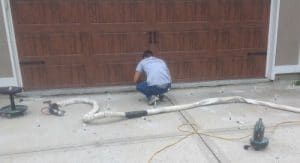What Is Brutalist Design? The History of This Raw, Minimal Design Theme
The words “Brutalist design” may not conjure up examples of architecture as easily as, say, “midcentury modern” or “Spanish Mission.” But you’re probably familiar with more Brutalist works than you think.
In fact, iconic Brutalist structures are rather unforgettable, including the Met Breuer museum in New York City and Boston’s City Hall. These mammoth concrete buildings look almost scary, yet they represent a raw plainness and honesty in design that has been popular for decades.
Elements of Brutalist design also show up in the home in the form of exposed brick, poured concrete floors, sharp angles on case goods, and a color palette that skews neutral and gray.
“The Brutalist style gained popularity during the mid-2010s, as seen in the many industrial and loftlike designs that brought in concrete countertops, minimalist furniture styles, and monochromatic colors,” says Drew Henry of Design Dudes.
It’s hard to say whether this rough and tough design theme is making a comeback at home, especially since we’ve come to embrace cozy interiors during the coronavirus pandemic.
“Home decor is trending toward more warm, welcoming vibes. I think we’re drifting away from hard, minimalist looks,” says Henry.
Still, if you’re keen on this style, read on for more about Brutalism, including its architectural roots and history, plus ways you can play with the look in your home.
The history of Brutalist architecture

Photo by Coates Design Architects Seattle
As with so many home design terms, Brutalism comes from a French phrase that means raw or unfinished concrete—and many cite Charles-Édouard Jeanneret, known as Le Corbusier, as the godfather of this look. The French-Swiss architect was known for the bare concrete columns that often appeared in the apartment houses he designed.
Brutalism grew out of the 1950s postwar era and was commonly used during the European reconstruction. London is home to more than 50 Brutalist buildings. This style also popped up on newly expanding American university campuses during the 1960s.
But it’s not just buildings that can be characterized as Brutalist.
“It’s most well known as an architectural style, but we also see it in sculpture and furniture design,” says Anna Brockway, co-founder of Chairish.
Alas, Brutalism fell out of favor in the 1970s, when architects viewed it as too hard to remodel, but some structures are still revered today and are protected for their historical value.
The hallmarks of Brutalist design

Photo by J. Brown, RA, LEED AP
Brutalist homes are no shrinking violets—their cool exteriors exude power and boldness and look like few others on most American streets.
“You’ll see lots of interesting angular shapes in this style that are only possible because they can be poured in concrete,” says Henry.
Steel and glass are also commonly used in Brutalist designs, as are rough surfaces and metallic hues.
Brutalism inside the home

What shows up on the runway and in other types of design tends to trickle down to your living room—and Brutalist designs are no different.
Concrete slabs, whether in the kitchen, on floors, or for walls, tend to signal Brutalism, as do other industrial touches such as rough-hewn wood, tables with natural edges, stone, and brick.
“We consider this a reemerging trend, as some people aren’t shying away from ultragraphic and shapely bronze, concrete, or plaster,” says Brockway.
Brutalist accessories

Small touches of Brutalist decor may be the best approach if you’re considering this style at home. Metal light fixtures with jagged cutouts or artwork that’s asymmetrical or sporting a weathered finish are two easy ways to add a touch of edgy industry to your rooms.
“The key here is not to overdo it—so it’s best to try an element here and there by way of sculpture, a mirror, or light fixture that adds texture, shape, and nuance to your home,” explains Brockway.
Brutalist furniture

Photo by Benjamin Rugs and Furniture
Blocky designs are another telltale Brutalist motif, and these shapes are best placed on console tables, hutches, and armoires.
As for the types of homes that are best suited to Brutalist design, look to midcentury modern and contemporary styles.
“These kinds of homes already incorporate the ethos of Brutalism, like poured concrete floors and minimalist decor and design,” says Brockway.







